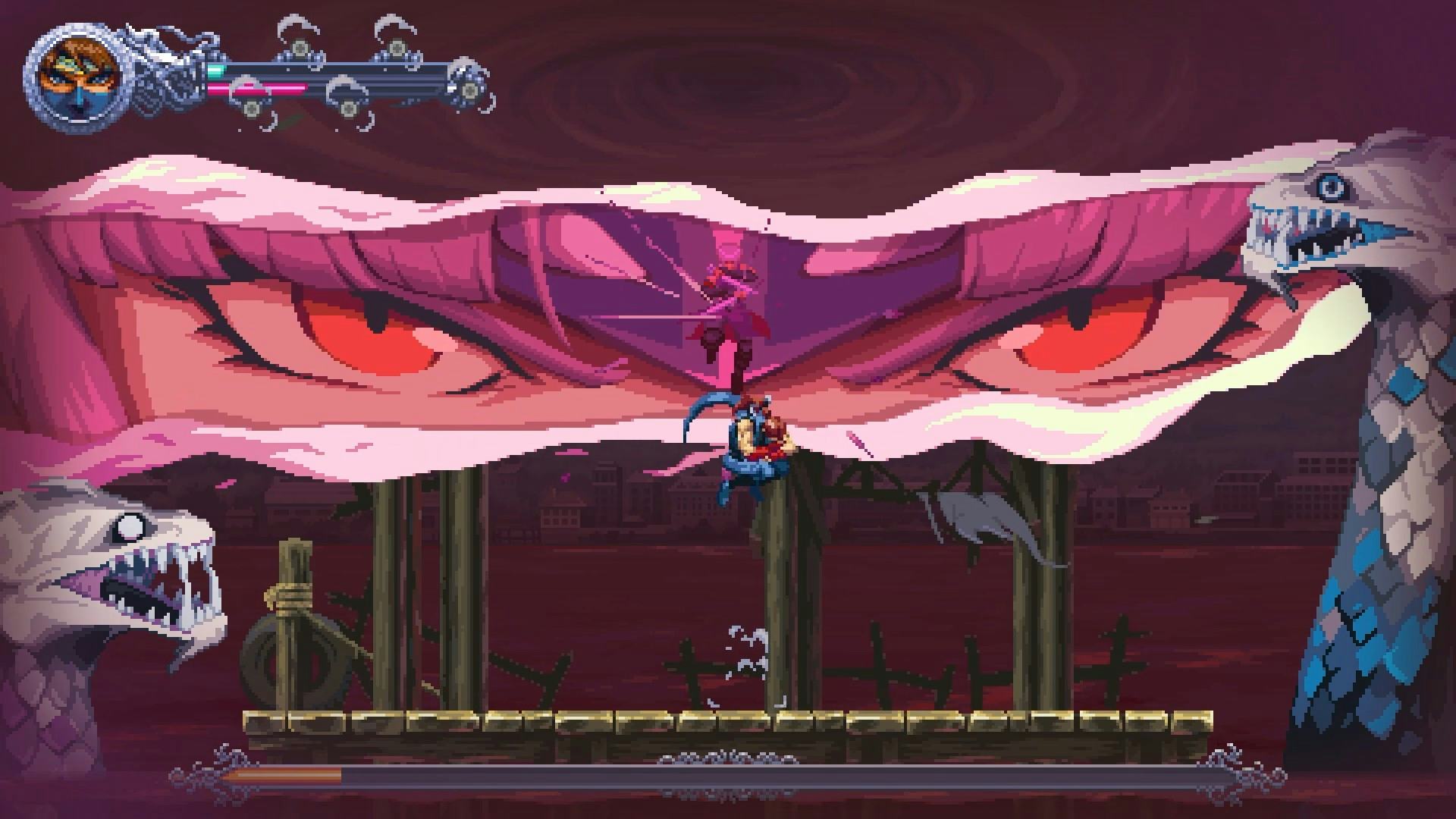
Nearly every single hour of Ninja Gaiden Ragebound, I’d be blown away by some incredible move or action sequence that I had no idea how I did — like hitting a ramp with a jet-ski, careening into an enemy soldier, and then jumping off them in midair. It was like my own choreographed action movie.
Ninja Gaiden Ragebound is one of the most superb-feeling platformers I’ve ever touched in my life — a pure adrenaline rush of a game that smartly doesn’t overstay its welcome. Everything in Ragebound feels like its nearly perfectly tuned, every element working in concert to add up to a great symphony. The Game Kitchen has absolutely nailed the vibe and feel of the classic Ninja Gaiden games, while simultaneously updating the formula into something that feels fresh and modern. This isn’t just a way to honor the legacy of Ninja Gaiden, it gives the series and entirely new lease on life.
In the Shadows

Ragebound is basically a revival of side-scrolling Ninja Gaiden and a sequel to the original two games all at once. Some unspecified amount of time after the originals, Ryu Hayabusa is training a young ninja named Kenji Mozu as his protege. During their training, however, a demon horde attacks the village and Kenji is thrown into the deep end. While Ryu heads to America, Kenji is tasked with stopping the demon threat in Japan.
But Ragebound’s most defining feature is its dual protagonists, with a Spider Clan ninja named Kumori serving as the deuteragonist. Through a twist of fate, the two leads’ lives become intertwined, and they even share a body — meaning you have two sets of moves to use at once.
If you’ve played the original Ninja Gaiden games, picking up Ragebound should be like hopping on a bike after years — that muscle memory simply clicks in. And what’s honestly beautiful about Ragebound is how simple it is. You have an attack button, a dodge, and a jump, and those are the only things you need to know, because everything else in the game is built upon and layered on top of those. You have two attack options, a sword slash from Kenji and a throwing dagger from Kumori — and a huge part of Ragebound is flip-flopping between these attacks.
As you move through the side scrolling levels, you’ll have to defeat enemies, solve puzzles, and do a ton of platforming to make it to the end — and in the spirit of the originals, Ragebound is quite difficult. Despite its apparent simplicity, Ragebound is an extremely challenging game that requires you to master its mechanics and movement, but pays dividends when you do.
The game gives you complete control of your characters, even down to the minutiae of stopping on a dime or cancelling a jump. Just the sheer movement alone feels immediately satisfying, but becomes even more when you start accounting for other technique. By hitting the jump button the moment you land on an enemy you can do a circular slash, damaging the enemy and acting as a platform. Then, there’s the new Hypercharge system, where certain enemies will glow wither turquoise (melee) or pink (ranged). If you eliminate this enemies with the corresponding attack you’ll get Hypercharge, which means the next attack you use can take out literally anyone in a single blow.

What’s brilliant about this system is that it almost makes Ragebound feels like a high-intensity puzzle game. Yes, you need to focus on speed and movement, but you also need to keep in mind the charges that enemies have, which types of enemies are appearing, and the most efficient way to eliminate them. This, more often than not, means platforming in smart ways or prioritizing who you attack first. There’s a real ebb and flow to the game’s formula, and it all clicks together.
But what helps Ragebound really soar is how smart the level design is, and how often it shakes up that core formula with inventive ideas. The pulse-pounding jet-ski escape sequence has you surging through enemies and objects alike. Another part might have you climbing up a tunnel to escape an incoming wall of fire. Yet another has you platforming between moving vehicles in a convoy, fighting American soldiers tooth and nail along the way. The same can be said for the game’s handful of boss battles, each of which sport a unique idea or challenge. While the variety is great, this can occasionally lead to some intense difficulty spikes, and a couple of them don’t measure up to the rest — feeling more frustrating than inventive.
But those issues are easily assuaged by the jaw-dropping presentation of Ragebound, as each level is given unique visual flair to help it stand out. If there’s a single word to describe the aesthestics of Ragebound, it’s evocative. It’s another aspect that manages to feel both nostalgic and fresh, intentionally riffing on the aesthetic of the original games, but fusing that with high-quality animations, sprites, and backgrounds. There’s so much color in this game that makes it pop off the screen — from the gnarly fountains of blood that spurt out of enemies, to the way fire sizzles on wooden structures. Ragebound is as much of a joy to look at as it is to play. Every single level ends up feeling remarkably different, either through some mechanical twist or gimmick, or through sheer visual style.
The Student Becomes the Teacher

Ninja Gaiden Ragebound is one of those games you finish and it feels like it’s gone by in the blink of an eye. While there can be some frustration in difficulty spikes, by and large it feels like a perfectly-paced experience that manages to find that sweet spot: not too short, but not too long. But nearly every minute of its six-ish hours is sublime.
I can see myself going back to Ragebound for years to come — popping in for a replay every now and again, because it simply feels that good to play. While Ninja Gaiden 4 is still on the way, Ragebound makes a bold statement that the series side scrolling legacy still holds plenty of promise. Ninja Gaiden is back, and hopefully it’s here to stay.
9/10
Ninja Gaiden Ragebound is available on PS4, PS5, Xbox One, Xbox Series X|S, Nintendo Switch, and PC. Inverse reviewed the PC version.
INVERSE VIDEO GAME REVIEW ETHOS: Every Inverse video game review answers two questions: Is this game worth your time? Are you getting what you pay for? We have no tolerance for endless fetch quests, clunky mechanics, or bugs that dilute the experience. We care deeply about a game’s design, world-building, character arcs, and storytelling come together. Inverse will never punch down, but we aren’t afraid to punch up. We love magic and science-fiction in equal measure, and as much as we love experiencing rich stories and worlds through games, we won’t ignore the real-world context in which those games are made.



!["[T]he First and Fifth Amendments Require ICE to Provide Information About the Whereabouts of a Detained Person"](https://images.inkl.com/s3/publisher/cover/212/reason-cover.png?w=600)



